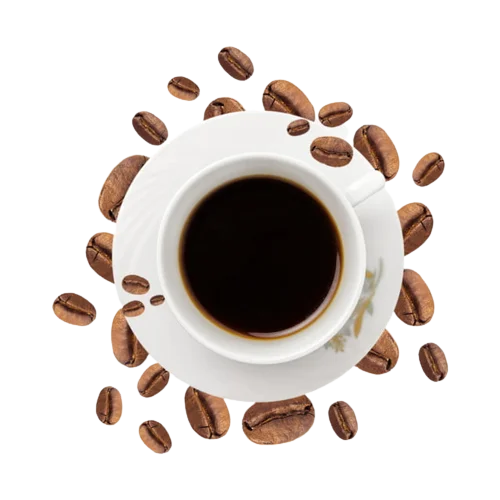Cost Breakdown of Developing a Food Delivery App in 2025: Features, Tech Stack & Timeline
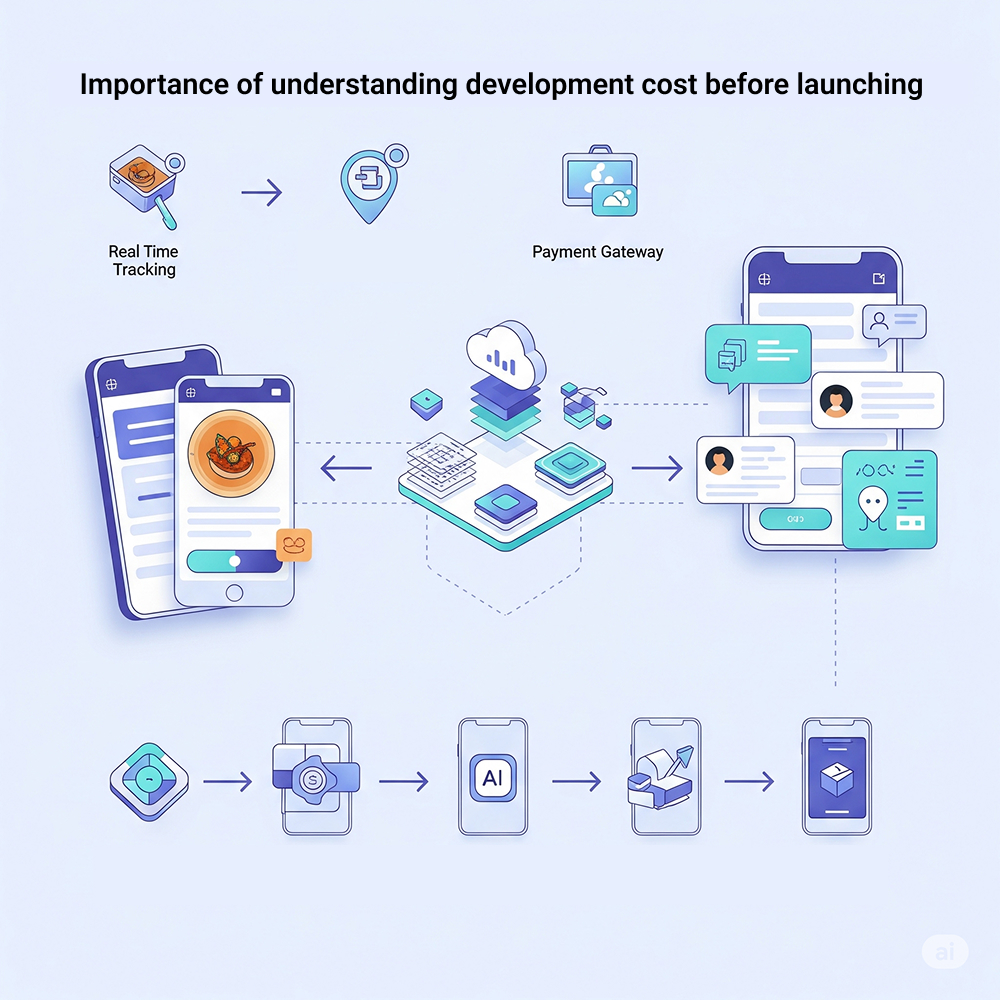
The convenience of having food delivered right to your doorstep has cemented food delivery apps as an indispensable part of modern life. From bustling city centers to quiet suburbs, these platforms have revolutionized how we eat. If you're looking to enter this lucrative market, understanding the cost breakdown of developing a food delivery app is your first crucial step. In 2025, several factors influence this cost, including features, chosen tech stack, and development timeline. This guide will help you navigate the complexities of food delivery app development and explore various food delivery app development services available.
Let's dive into what it takes to build a successful food delivery application and how to choose the right food delivery app development company.
The Core Components: What Does a Food Delivery App Entail?
A robust food delivery ecosystem isn't just one app; it typically involves three distinct applications, each tailored for a specific user group, along with a powerful administration panel. This forms the foundation for any on-demand food delivery app development.
- Customer App:This is the face of your business, where users browse restaurants, place orders, track deliveries, and make payments.
- Restaurant App/Panel: This interface allows restaurants to manage their menus, accept or reject orders, update order statuses, and track their earnings.
- Driver App: Designed for your delivery personnel, this app helps them manage new orders, navigate to restaurants and customers, and update delivery statuses.
- Admin Panel: The central control hub for you, the business owner. This powerful dashboard allows you to manage users, restaurants, drivers, orders, payments, promotions, and analytics.
Each of these components requires careful planning and development, significantly contributing to the overall cost of your food delivery application development.
Key Features and Their Impact on Cost
The more features you include, the higher the development cost. Here's a breakdown of essential and advanced features that any food delivery app development company will discuss with you:
1. Customer App Features
- User Registration & Profiles:(Basic) Email, social media login, profile management.
- Restaurant Listing & Search:(Basic) Browse by cuisine, restaurant name, ratings, distance. Filters are crucial here.
- Menu Display:(Basic) Clear presentation of food items, descriptions, prices, customization options.
- Shopping Cart:(Basic) Add/remove items, quantity adjustments, subtotal.
- Payment Integration:(Essential) Multiple payment gateways (credit/debit cards, digital wallets like Stripe, PayPal, Apple Pay, Google Pay). This is non-negotiable for user convenience.
- Real-time Order Tracking:(Essential) GPS-based tracking of delivery status from restaurant to doorstep. Highly valued by users, especially in on-demand food delivery app development.
- Order History:(Basic) View past orders and reorder options.
- Ratings & Reviews:(Essential) Users can rate food and delivery service, providing valuable feedback.
- Push Notifications: (Essential) Updates on order status, promotions, special offers.
- Promotions & Discounts: (Advanced) Promo codes, loyalty programs, referral bonuses. Crucial for app development for food business growth.
- Customer Support: (Basic) In-app chat or call options.
- Personalized Recommendations:(Advanced) AI/ML-driven suggestions based on past orders and preferences. These are part of robust custom food delivery software solutions.
- Scheduled Orders: (Advanced) Ability to place orders for a future date/time.
- Saved Addresses: (Basic) Quick selection of delivery locations.
2. Restaurant App/Panel Features
- Restaurant Registration & Profile: (Basic) Onboarding, managing business details.
- Menu Management: (Essential) Add, edit, remove dishes, update prices, manage availability (e.g., "sold out" items).
- Order Management: (Essential) Receive new orders, accept/reject, update status (preparing, ready for pickup).
- Order History:(Basic) View completed and canceled orders.
- Earning Reports:(Basic) Track daily, weekly, monthly sales.
- Push Notifications:(Essential) Alerts for new orders.
- Promotional Tools:(Advanced) Create and manage special offers for customers.
- Staff Management:(Advanced) Assign roles and permissions to kitchen staff or managers.
3. Driver App Features
- Driver Registration & Profile: (Basic) Onboarding, document verification.
- Order Requests: (Essential) Receive and accept/reject delivery requests.
- Navigation & Route Optimization: (Essential) In-app GPS for efficient delivery routes, a cornerstone of on-demand food delivery app development.
- Order Status Updates: (Essential) Mark orders as picked up, delivered, etc.
- Earning Dashboard:(Basic) View daily/weekly earnings.
- Push Notifications:(Essential) Alerts for new assignments.
- Delivery History: (Basic) Record of past deliveries.
- In-app Chat/Call:(Basic) Communicate with customers and restaurants.
4. Admin Panel Features
- Dashboard & Analytics: (Essential) Overview of key metrics (orders, revenue, active users, drivers).
- User Management: (Essential) Manage customer, restaurant, and driver accounts.
- Restaurant Management: (Essential) Add/remove restaurants, manage commissions.
- Driver Management: (Essential) Onboard, track, and manage drivers.
- Order Management:(Essential) View and manage all ongoing and past orders.
- Payment & Commission Management: (Essential) Handle transactions, commissions, refunds.
- Promotions & Marketing Management: (Advanced) Create and manage campaigns.
- Content Management: (Basic) Manage static pages (About Us, Contact, FAQs).
- Customer Support & Dispute Resolution: (Essential) Handle queries and complaints.
- Reporting & Analytics: (Advanced) Detailed insights into business performance. These advanced features fall under custom food delivery software solutions.
Tech Stack: The Engine Behind Your App
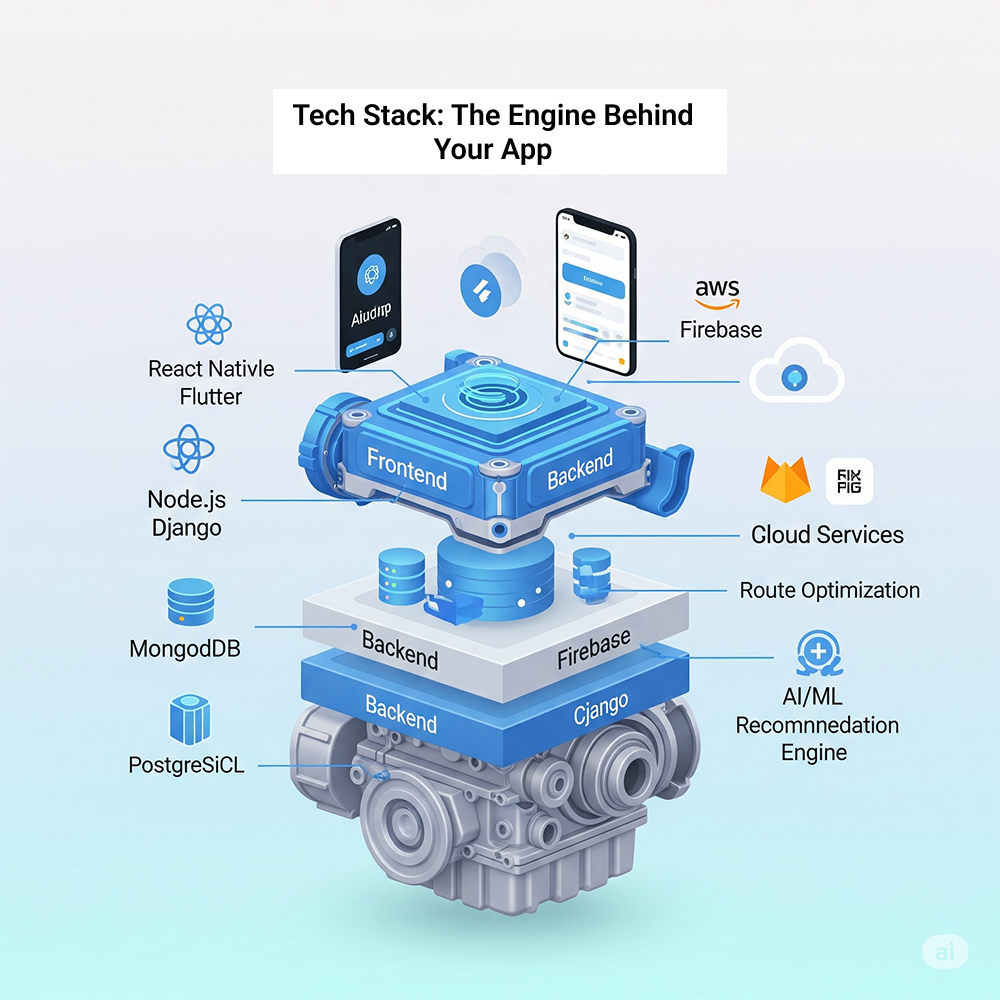
The technologies you choose significantly impact development time and cost for your food delivery application development. A seasoned food delivery app development company will guide you through these choices.
Mobile App Development (Customer, Restaurant, Driver Apps)
-
Native Development (Higher Cost, Best Performance):
- iOS: Swift, Objective-C
- Android: Kotlin, Java
- Pros: Superior performance, access to all device features, best user experience.
- Cons: Requires separate codebases, higher development cost and time.
-
Cross-Platform Development (Moderate Cost, Good Performance):
- React Native: JavaScript
- Flutter:Dart
- Pros: Single codebase for iOS and Android, faster development, lower cost.
- Cons:May have performance limitations for highly complex features, limited access to native APIs. This is a common choice for budget-conscious food delivery app development services.
-
- Programming Languages: Node.js, Python (Django/Flask), Ruby on Rails, PHP (Laravel), Java (Spring Boot). Node.js and Python are popular choices for their speed and scalability, vital for on-demand food delivery app development.
- Databases:
- SQL: PostgreSQL, MySQL (good for structured data, transactions).
- NoSQL: MongoDB, Cassandra (flexible, scalable for large, unstructured data, often used for real-time data like tracking).
Backend Development (API & Database)
Other Key Technologies
Development Timeline: Key Stages and Duration for Food Delivery App Projects
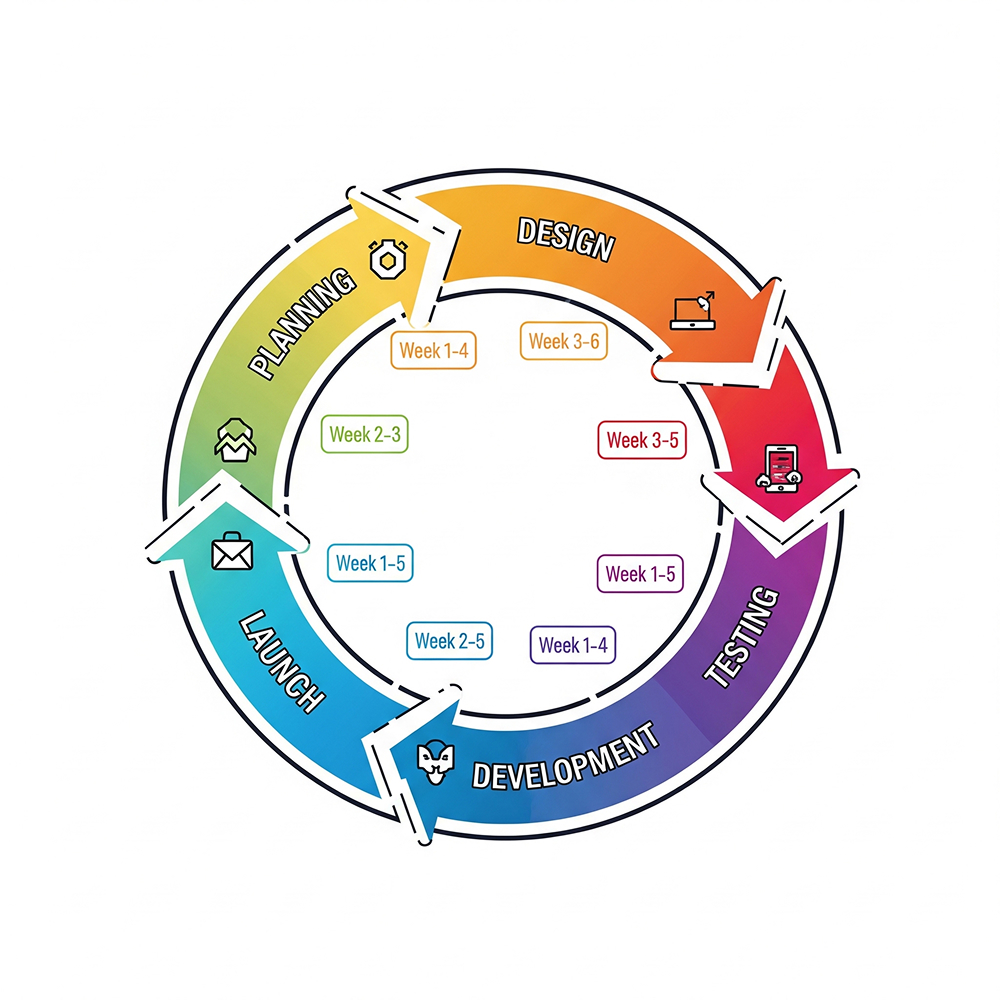
The timeline directly correlates with cost, as development agencies typically charge hourly or on a project basis determined by estimated hours for food delivery app development services.
Here's a generalized timeline:
-
Discovery & Planning (2-4 weeks):
- Market research, feature finalization, wireframing, technical architecture, project scope definition.
-
UI/UX Design (4-8 weeks):
- Creating user flows, wireframes, prototypes, and the visual design for all three apps and the admin panel.
-
Backend Development (10-20 weeks):
- Building APIs, database schema, server logic. This is often the longest phase.
-
Mobile App Development (8-16 weeks per platform/cross-platform):
- Developing the customer, restaurant, and driver apps. Cross-platform development can shorten this.
-
Admin Panel Development (6-12 weeks):
- Building the web-based management dashboard.
-
Quality Assurance (QA) & Testing (4-8 weeks):
- Rigorous testing to identify and fix bugs, ensure functionality, performance, and security.
-
Deployment & Launch (1-2 weeks):
- Publishing apps to App Stores, server setup.
-
Post-Launch Support & Maintenance (Ongoing):
- Bug fixes, updates, new feature development. This is a recurring cost.
A simple food delivery app (Minimum Viable Product - MVP) might take 4-6 months. A feature-rich, complex application for custom food delivery software solutions could easily take 8-12 months or more.
The Cost Breakdown: Putting It All Together
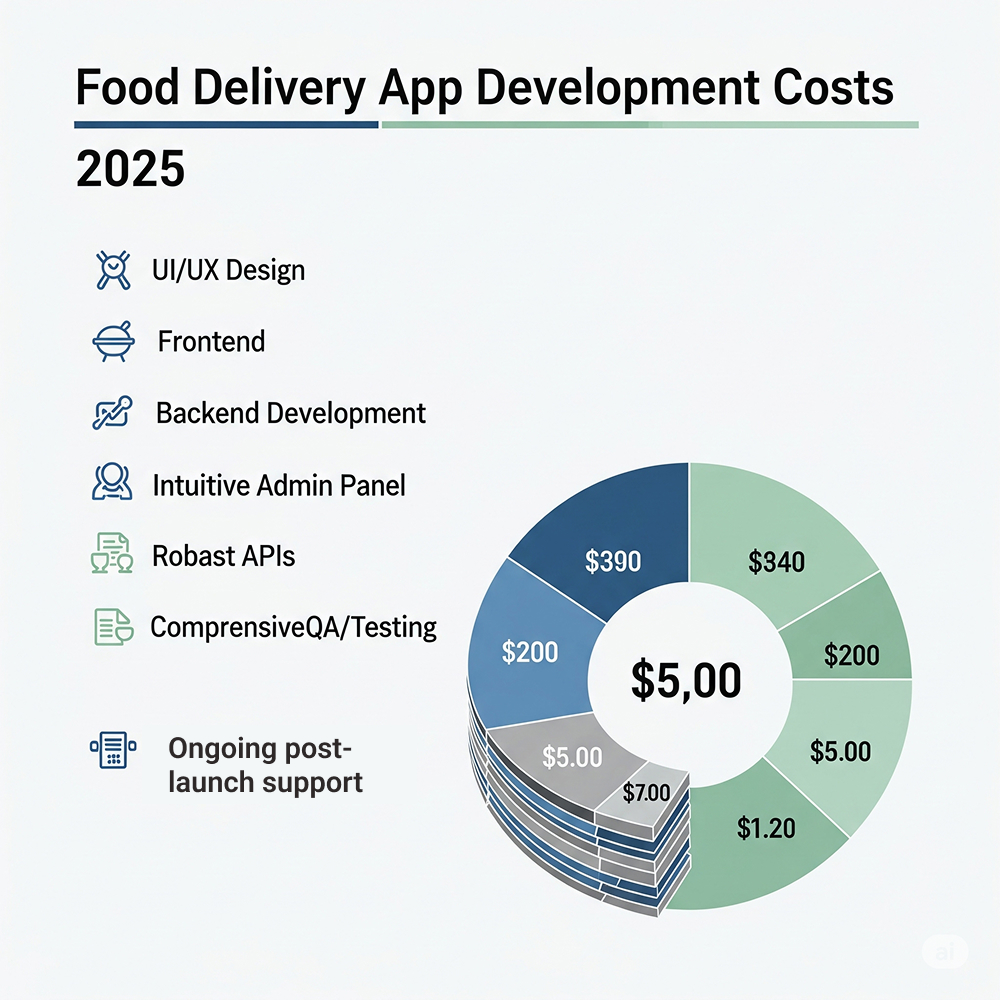
The cost of developing a food delivery app varies widely based on geographic location of the development team, features, and complexity. This is where researching various food delivery app development companies becomes essential.
Here's an estimated range based on development team location:
-
North America (USA, Canada):
- Hourly Rates: $100 - $250+
- Total Cost (MVP): $150,000 - $350,000+
- Total Cost (Feature-rich):$400,000 - $800,000+
- Pros: High quality, strong communication.
- Cons: Highest cost.
-
Western Europe (UK, Germany, France):
- Hourly Rates:$70 - $180
- Total Cost (MVP): $100,000 - $250,000
- Total Cost (Feature-rich): : $300,000 - $600,000
- Pros:High quality, good communication, similar time zones for collaboration.
- Cons: Highest cost.
-
Eastern Europe (Ukraine, Poland, Romania):
- Hourly Rates: $40 - $90
- Total Cost (MVP): $60,000 - $150,000
- Total Cost (Feature-rich):$200,000 - $400,000
- Pros: Excellent talent, cost-effective, strong technical expertise in food delivery application development.
- Cons: Potential time zone differences.
-
Asia (India, Vietnam):
- Hourly Rates: $20 - $50
- Total Cost (MVP): $30,000 - $80,000
- Total Cost (Feature-rich): $100,000 - $250,000
- Pros: Most cost-effective, large pool of developers offering comprehensive food delivery app development services.
- Cons: Varies in quality, potential communication challenges, significant time zone differences.
Average Breakdown of Costs (Approximate % of Total for Food Delivery App Development):
- Discovery & Planning: 5-10%
- UI/UX Design:10-15%
- Mobile App Development (x3 apps): 30-40% (split across customer, restaurant, driver apps)
- Admin Panel Development: 10-15%
- QA & Testing: 10-15%
- Project Management (Integrated throughout): 10-15%
Hidden / Ongoing Costs to Consider for your Food Delivery Application:
- Server Costs:Cloud hosting fees scale with user base.
- Third-Party API Costs:Fees for payment gateways, SMS services, mapping APIs.
- Maintenance & Updates: Bug fixes, security updates, feature enhancements.
- Marketing & Promotion: Essential for user acquisition and app development for food business growth.
- Legal & Compliance: Data privacy (GDPR, CCPA), food safety regulations.
Tips for Managing Costs
- Start with an MVP (Minimum Viable Product):Launch with core features to test the market, gather feedback, and iterate. This significantly reduces initial investment in food delivery app development.
- Prioritize Features:Distinguish between "must-have" and "nice-to-have" features. Add advanced functionalities in later phases. This directly impacts the complexity of custom food delivery software solutions.
- Choose Cross-Platform Development: For budget-conscious projects, React Native or Flutter can save substantial time and money on food delivery app development services.
- Outsource Strategically:Consider outsourcing to regions with lower hourly rates if you can manage communication effectively. Many food delivery app development companies specialize in this model.
- Hire an Experienced Development Partner: A skilled team can offer valuable insights, optimize processes, and avoid costly mistakes, ensuring successful on-demand food delivery app development.
- Clear Communication & Documentation: Ambiguity leads to rework, which costs money. Ensure all requirements are well-documented.
Conclusion
Developing a food delivery app in 2025 is a significant investment, but with careful planning and a clear understanding of the cost drivers, it can yield substantial returns. Focus on building a robust, user-friendly MVP first, then scale by adding advanced features based on market demand and user feedback. By strategically choosing your features, tech stack, and partnering with the right food delivery app development company, you can navigate the complexities and build a successful food delivery application that stands out in a competitive market and drives significant app development for food business growth.
Are you ready to bring your food delivery app idea to life with expert food delivery software solutions?
